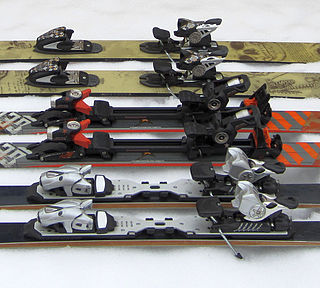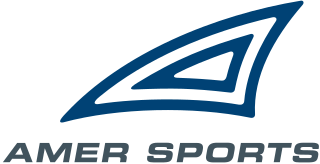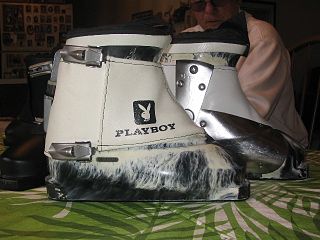
Snowboards are boards where the user places both feet, usually secured, to the same board. The board itself is wider than most skis, with the ability to glide on snow. Snowboards widths are between 6 and 12 inches or 15 to 30 centimeters. Snowboards are differentiated from monoskis by the stance of the user. In monoskiing, the user stands with feet inline with direction of travel, whereas in snowboarding, users stand with feet transverse to the longitude of the board. Users of such equipment may be referred to as snowboarders. Commercial snowboards generally require extra equipment such as bindings and special boots which help secure both feet of a snowboarder, who generally ride in an upright position. These types of boards are commonly used by people at ski hills, mountains, backcountry, or resorts for leisure, entertainment, and competitive purposes in the activity called snowboarding.
A ski is a narrow strip of semi-rigid material worn underfoot to glide over snow. Substantially longer than they are wide, and characteristically employed in pairs, skis are attached to ski boots with ski bindings, with either a free, lockable, or partially secured heel. For climbing slopes, ski skins can be attached at the base of the ski.

A ski binding is a device that connects a ski boot to the ski. Before the 1933 invention of ski lifts, skiers went uphill and down and cross-country on the same gear. As ski lifts became more prevalent, skis—and their bindings—became increasingly specialized, differentiated between alpine (downhill) and Nordic styles of skiing. Until the point of divergence in the mid-20th century, bindings held the toe of a flexible, leather boot against the ski and allowed the heel to rise off the ski, typically with a form of strap or cable around the heel.
Ski boots are footwear used in skiing to provide a way to attach the skier to skis using ski bindings. The ski/boot/binding combination is used to effectively transmit control inputs from the skier's legs to the snow.

Salomon SAS is a French sports equipment manufacturing company headquartered in Annecy, France. It was founded in 1947 by François Salomon in the heart of the French Alps and is a major brand in outdoor sports equipment. Salomon is owned by Finnish retail conglomerate Amer Sports, along with Wilson, Atomic, Precor, and Arc'teryx, among others.
Suunto Oy is a Finnish company that manufactures and markets sports watches, dive computers, compasses and precision instruments. Headquartered in Vantaa, Finland, Suunto employs more than 300 people worldwide, and its products are sold in over 100 countries. Although globally active, the headquarters is placed next to the factory, in which most of the work stages are still handcrafted. Suunto was a subsidiary of Amer Sports, owned since 2019 by the Chinese group Anta Sports, with sister brands Wilson, Atomic, Sports Tracker, Salomon, Precor, Arc'teryx. In May 2022, Chinese technology company Liesheng acquired Suunto from Amer Sports.

Fischer Sports is an Austrian winter sports equipment manufacturing company, more specifically Nordic skiing, Alpine skiing and ice hockey equipment. Winter sports equipment include skis, boots, bindings, and accessories. For ice hockey, Fischer produces sticks, skates, pucks, blades, jerseys, and protective gear.

Amer Sports Oy is a Finnish multinational sporting equipment company based in Helsinki, Finland. Established in 1950 as an industrial conglomerate with interests as diverse as tobacco trading, ship owning and publishing, Amer has gradually evolved into a multinational firm devoted to the production and marketing of sporting goods. The company employs over 9,700 people.
Volant is a brand of ski equipment, currently owned by Amer Sports. It was founded as an independent company in the US, by brothers Hank and Bucky Kashiwa in 1989. The brothers developed the stainless steel "cap" ski, and founded the company with the belief that stainless steel skis would provide better performance than skis made from other materials.

Anta Sports Products Limited is a Chinese sports equipment multinational corporation headquartered in Jinjiang, China. It is the world's largest sports equipment company by revenue and third-largest manufacturer of sporting goods overall, behind Nike and Adidas.

Spademan was a type of ski binding, one of a number of "plate bindings" that were popular in alpine skiing during the 1970s. It used a bronze plate screwed into the bottom of the boot as its connection point, held to the ski by a clamp-like mechanism that grasped the side of the plate. Unlike conventional bindings, the Spademan could release in any direction, in response to any force or torque. It provided greatly improved protection compared to contemporary designs, which generally allowed release of the toe to the sides and heel directly forward, keeping the foot attached in any other fall direction.

Sports Tracker, earlier Nokia Sports Tracker, was originally a software tool for Symbian Series 60 phones that allowed its user to track their route, speed, timings and energy expenditure, while engaging in a sport activity such as running, jogging or cycling.
Hanson Industries invented and popularized the rear-entry ski boot. Formed by brothers Chris and Denny Hanson in 1969, the company became a huge success in the late 1970s. A series of missteps in the early 1980s led to a rapid death spiral and the company went bankrupt in 1984. It was purchased by Daiwa, a Japanese fishing tackle company that handled Hanson's distribution in Japan. Daiwa ended sales in North America and Europe. European products, notably the famous Salomon SX series, used Hanson's exit as a springboard to market domination during the second half of the 1980s. Denny Hanson later introduced the "Apex" design, which combines features of alpine and snowboarding boots.

Rosemount Ski Boots introduced one of the earliest all-plastic ski boots for the downhill skiing market, competing with Bob Lange for the title of "first". Rosemount's design was easily distinguished by its use of the uncommon "side-entry" method for putting the boot on, which was rare at the time and is no longer used.

Lange is a major producer of ski boots used in alpine (downhill) skiing. They introduced the world's first plastic ski boots in 1962, and a greatly improved model aimed at the racing market in 1965. After several World Cup and Olympics wins in 1967 and 1968 made them a must-have on the circuit, Lange has remained a force in the racing market ever since. Their boots have equipped five times as many World Cup medal winners as any other brand into the 2000s. The front-entry design introduced by Lange is used by almost every modern ski boot to this day. Lange remains a major brand worldwide.











